The Simple Genius of Super Mario Bros 3 Maps
By Vookatos 5 Comments
There's something cool about video game maps to me. When speaking about maps, I don't mean those that show your position in an open-world or a dungeon, but those that creatively showcase the world around you in games that consist only of levels or missions.
Nowadays maps like that are common and mostly used in platformers. Not surprising, as they're often stylish and interesting, and are way better than plain menus. They offer players a natural stopping point and make the levels, which are usually quite abstract, feel like they belong to an actual world.
Of course, not all games do that perfectly. Some, like Super Meat Boy, offer just a more interesting version of a level select screen. However, games that do map screens well usually nail them. Take Kirby's Epic Yarn, for example. Upon beating each world the player is returned to a room that looks and plays much like a normal level. The player will have a badge that they can drop to reveal a new level. Simple enough. However, the presentation is so unique, that animations of levels opening could be described as rewards. For example, one of the badges that you obtain is a clock. Upon throwing a clock, it goes to a specific spot near a sleeping bear. Clock rings, wakes up the bear, bear stretches and moves the ground above him just enough so that you could reach the door to the next level. Adorable!
One of the most famous series that uses map screens is Super Mario. That is no surprise, since not only did Super Mario Bros. 3 introduce the concept to a lot of gamers, but also evolved it over later games.
Amidst all this, it's easy to dismiss Mario 3's maps as something similar and something that we've all seen too many times. A level select with a themed board around it. However, I would disagree. I think maps in Mario 3 are quite unique even nowadays since the game did so much with such a basic concept. So let's explore it, shall we?
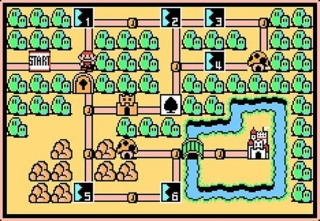
The map screens of Mario 3 look and behave a lot like a board game. Mario can move along the paths to spaces with a level on them, and go further upon beating a level. There are bonuses on the map – Toad Houses and Minigame Houses – which the player can travel to at any time as it's possible to walk through them. The boards are themed, so each World looks and sounds different from its predecessor, which adds to the charm. In World 1 you walk along hills that dance to the beat of the music, while in World 6 you’re moving through a frozen land covered in ice.
The first thing such a map presents you with is choice. In the very first world, you can go to 1-3 and 1-4, or skip them entirely. Clearing one of the levels can open up a path to a Toad House. Better players can go to both levels, while collecting coins, power-ups, and lives along the way. Players who aren't experienced, however, can just go ahead and skip levels they find too challenging or try just one of the levels to get a reward. Failure doesn't always mean you're stuck on one level.
Then we get to Fortresses. They act much like Castle levels from Super Mario Bros. and feature a boss at the end. However, what's interesting about Castles in Mario 3, is that they provide you with a checkpoint. Once you clear a Fortress, a path opens up on the map, allowing you to move through it even once you lose all your lives, and all previously cleared levels become roadblocks again.
There is an obvious parallel to recent Mario games, where a Castle level would allow you to save and just continue your progress from the point as you game over. However, there is a bit of a difference with Mario 3. That difference lies within the last level of the world – the Airship. Once you get to the King’s Castle and board the Airship, death on the level will cause the Airship to fly away to a different point on the map. That way the last level of the world becomes its ultimate test. If you can’t beat it in one go, you’re punished, and if you game-overed and used a shortcut, or skipped levels before, you might have to replay levels to get to the Airship again.
I’m one of the people who think that game overs aren’t needed in games, but I must admit that it’s a pretty creative use of them. Levels in Mario 3 are short, so if you’re good, you can clear them in a minute, especially if you’ve beaten them before. Replaying the levels isn’t the challenge. Playing through levels you’ve skipped over because they were too difficult, though, is. That way you're also provided with a bit of training. If you're good enough, just chase the Airship and board it again. If you're not, maybe play a different level first.
Another curious thing on the World 1 map is an Enemy space. Every time you exit a level, either via death or beating it, a little Hammer Bro moves around the map. They don’t walk too much and stay near where they started, though. The enemy space triggers a short level, different in each world, where Mario needs to defeat all the enemies and gives you a chest with a power-up. Speaking of...
There is a helpful feature that is only available on the map screen: the Inventory! The inventory stores all the power-ups you get from chests. Those chests appear in Toad Houses, Enemy spaces, and sometimes other places, some of which are hidden. The items you get can only be used once, but they can help you in many ways. There are a lot of simple power-ups that give you transformations, from a simple mushroom to a Star, that gives you invincibility for a short time when a level starts. However, there are also some rare ones. Cloud lets you move over a level space (without clearing it, so you have to be really careful so you don't need to come back through it), Music Box can make enemies go to sleep, so you can walk over them, P-Wing can give you infinite flight within a level, etc.
Now we’re getting somewhere. Pretty much all the features I’ve mentioned have become common for Mario games. However, Mario 3 doesn’t stop there.
Super Mario Bros. was a game with many secrets, so it’s pretty obvious that a sequel would have them, too. However, Mario 3 also differs from lots of games that came after it, because it had secrets not only inside the levels but also on the map.
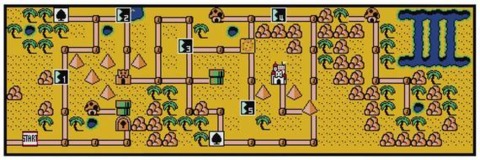
World 2, the Desert Land, is the first one where you can obtain multiple rare power-ups, including the hammer. Hammer lets you break a rock on the map to reveal a secret screen with an Enemy space on it which rewards you with a Warp Flute. There are also secrets which you can get in almost every world by performing a highly specific task within a level (or just being lucky and stumbling across them), such as the Treasure Ship or a White Toad House.
There aren’t any actual secret levels on the map, which might be disappointing nowadays, but it’s understandable. The game already has a lot of optional stuff with the ability to skip levels, so secrets that allow you to gain more lives, power-ups, or straight-up skip worlds might be more useful to players who find the game too challenging as opposed to secret with an extra-hard level.
World 2 also has a few unique things. Well, it’s just levels, but they are not numbered spaces, and instead, they’re depicted as a quicksand spot and a pyramid on the map. They don’t really differ from other levels, but they should pique your curiosity when you first see them, which is neat. The Quicksand level famously features the Angry Sun, while Pyramid is less gimmicky and mainly exists to provide you with a context for where you are in the world. By placing a little pixel icon on the map it transforms a simple underground maze into something else!
Next, there’s World 3, which is a whole different beast. Water Land introduces bridges that rise up and come down every time player dies or clears a space. When the bridges are up, you can’t cross them. Simple gimmick, but fitting for the world. With the introduction of pipes on the map in World 2, some Map screens start to feel like a maze that you have to navigate and think about. It won't ever matter for an experienced player, but, as with Airship level flying away, a newbie might want to think about how to traverse the land. Also, there’s a little boat you can ride from the dock, which is charming.

World 3 also might be the first place where players realize that position of Level spaces on the map can tell you a fair bit about the level. If the space is on land, it’s going to be another ground level. Opposite when it’s in water, of course. There are also spaces that are only partly in the water, which means that level most likely won’t have any bottomless pits but will feature a water segment, even if you mostly walk along the ground. This might help you avoid levels you don't want to play just by looking at them. I'm not that intimately familiar with Mario 3 and can't tell you what type of level 3-5 is, but by looking at the map, I can see that it's a water level. Like many, I'm not a fan of those, so it helps me choose certain levels that I like less when I'm in the mood for them.
Considering the map was a new idea, I wouldn’t be surprised if developers got some of the level ideas while designing the map. Might sound farfetched, but I like to think that way about a level in World 5. World 5 starts on land, looking much like the World 1 map. However, it only has 5 levels, 2 of which are Fortress, and a Tower, which uses a new sprite for a level image. The Tower is a first vertical level, and it has multiple floors. Once you go through all the floors, get to the roof. Then you can go even higher, and finally, you reach the second part of the map. Suddenly you’re in the sky, on the second part of the map, and you can see the small part of World 5 which you just beat way below. The Tower Level doesn't even have a proper end. You don't get a card or collect an orb, you just go through a pipe.
Of course, I don’t have any proof that the Tower level was designed after developers decided to break up Sky Land into a ground and a sky portion, but the way it surprises you with a sudden theme change is still very cute. Also, I quite like that on the Sky portion of the map you can see star icons, much like images of power-ups that you could always see in the sky of above-ground levels.
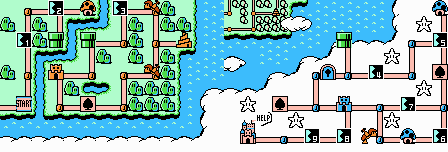
There is a similar situation in World 8. The game’s last world is broken into four sections, the third of which is covered in darkness. The two numbered levels on this map are also the only non-special levels, and they take place during the nighttime. The dark section of the map provides a bit of a challenge in a form of a small maze. It’s not hard, but it might confuse you for a second, since it has two pipes, one leading to the other, at the same screen. They aren’t far apart, but since visibility is so low, you might think that you’ve gone to a different screen altogether.
The entirety of World 8 is quite interesting. Bowser’s World is covered in fire. It also contains lots of skulls, including a dirty lake in the first section of the map. A shame that this theme, only with more lava, will be reused so many times in the series, and by different games. Mario 3's final world is almost entirely different from any other in the series. There's almost no lava in it, aside from Fortress and the final level. I suppose there's a bit of a secret too. You might assume that the lake on the first screen, which also appears in the ship level is deadly since it looks different from water (and the lake itself is a skull!), but you can actually swim in it, and skip the level from underneath! Another difference is that this world has almost no numbered levels. The only two normal levels are placed on the dark map, which doesn’t have any fire, and the levels themselves take place at night.
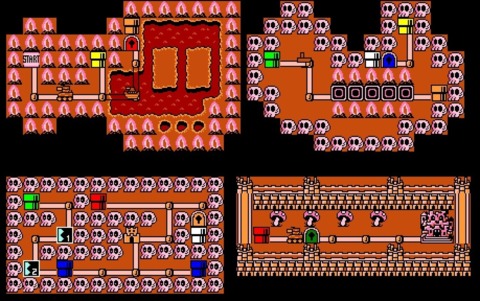
The rest of the levels in World 8 are all unique levels. The only familiar one out of all of them is a fortress level, while the rest are all new. The first map contains a Tank and a Ship level. The second one has Airboats, and the fourth one has the Bowser’s Castle, which uses a unique sprite. All of the aforementioned levels, except for the final castle, are really neat auto scrollers that feel like you’re finally in the enemy territory, and that you’re the one being attacked. In fact, there is a small tweak to how the map works in regard to those new levels which helps the atmosphere. When Mario moves to them on the map, the level starts automatically, without the need to press A. The only times you saw that before would be with all the Enemy challenges and Bonus spots.
I would like to think that this was done on purpose, to make the player feel like Mario is being attacked, and doesn’t have any more choice but to push forward. He can't just stand where the tanks are, as they are moving towards him. After all, aside from a few shortcut pipes, the map is very linear, especially in the final screen, which is a straight line. There’s no way to skip a level in World 8.
Another thing of note in World 8 is a weird set of squares on the second screen. While moving on them, Mario stops on three out of five squares, and there is a chance that a hand might appear and grab him. If that happens, you will be teleported to a small challenge level. All three levels are different, and if you beat them, you’re rewarded with a chest and can pass through it freely, much like a beaten level.
Those levels aren’t my favorite, but the idea behind them is neat. Of course, Bowser would have traps, why wouldn’t he. It makes sense in-universe. It also provides another surprise for the player. By this time you figured out how levels work, even if they have unique spots on the map, so it's unexpected, especially if nothing happens on the first of those squares. When I was a kid, it was quite scary when one of those arms suddenly reached out on what I thought was weird, but a safe path.
Surprise feels like a constant theme with Super Mario Bros. 3. Almost every level has a new gimmick, and almost every map has something unexpected and new. To recap, Super Mario Bros. 3’s maps have: Level Spaces, Toad Houses, Game Houses, Bonus Game spaces, Treasure Ships, White Toad Houses, Enemy spaces (Hammer Bros. and Munchers), Pipes, Fortresses (including a Tower and Bowser’s Castle), King Castles, Unique Level spaces (Quicksand and a Pyramid) Tanks, a Ship, Airboats, and Hand Traps. Beyond that, there are secrets on almost every map, and there is a special map for the Warp Zone.
That is ambitious. I can’t think of any game that puts so much care into something that, on the surface, is just a level select. Even later Mario games never evolved the concept. While 3D Mario games have introduced large hubs for you to run around in, 2D games never improved on it. Super Mario World focused more on secrets within levels and levels having multiple exits, which was understandable. The New Super Mario Bros. series, however, stuck with most of Mario 3’s ideas and themes in terms of maps.
The latest game to introduce something new to the formula was Super Mario 3D World. It added the ability for players to move freely around the map. However, it never really did anything with it. You could find coins and lives, and there is a secret or two. Maps in 3D World also ditched any semblance of geography and made all levels into floating cubes. Of course, the game also supports up to four players, so it’s not surprising. Four people waiting for one person to move or pick a level wouldn’t be fun at all. Still, I wish it wasn’t so familiar.
I’m just rambling at this point. It might seem like I’m disappointed with newer Mario games when it isn’t the case at all. We’re talking about something as insignificant as maps, after all. Still, as great as newer Mario games are, Super Mario Bros. 3 and Super Mario World were the last surprising 2D Mario games for me, I can’t deny that. But, lucky for me, with Breath of the Wild and Super Mario Odyssey, it really seems like Nintendo wants to move away from familiar and into new and unexplored territories, and I can’t wait to see what comes next!

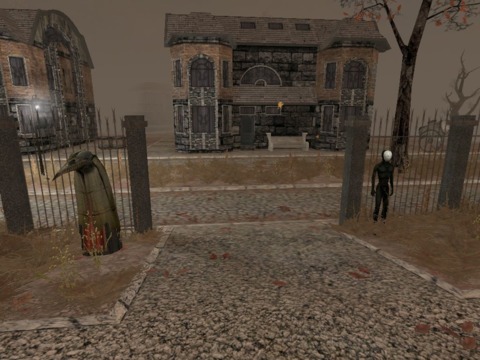

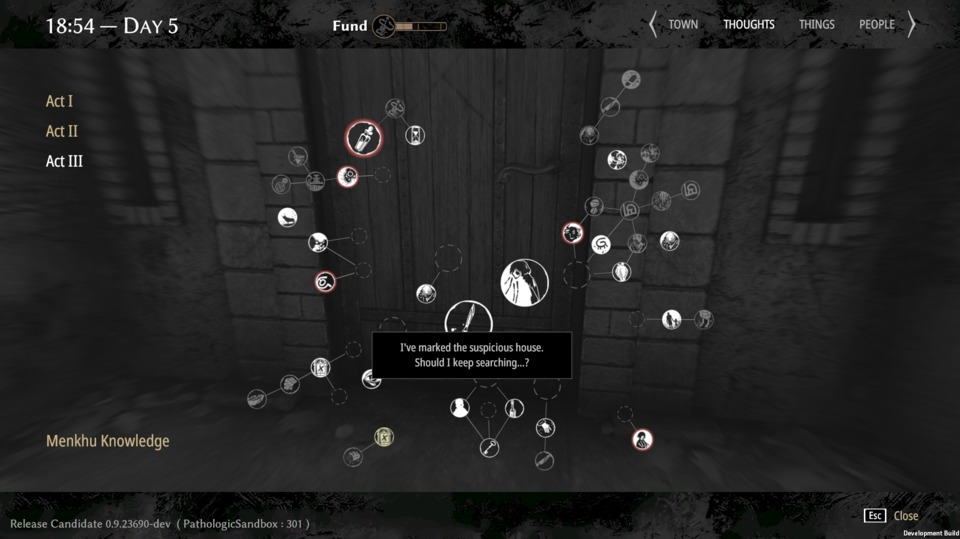
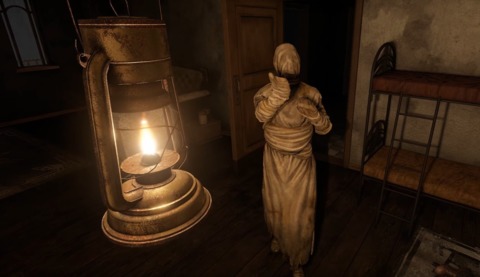
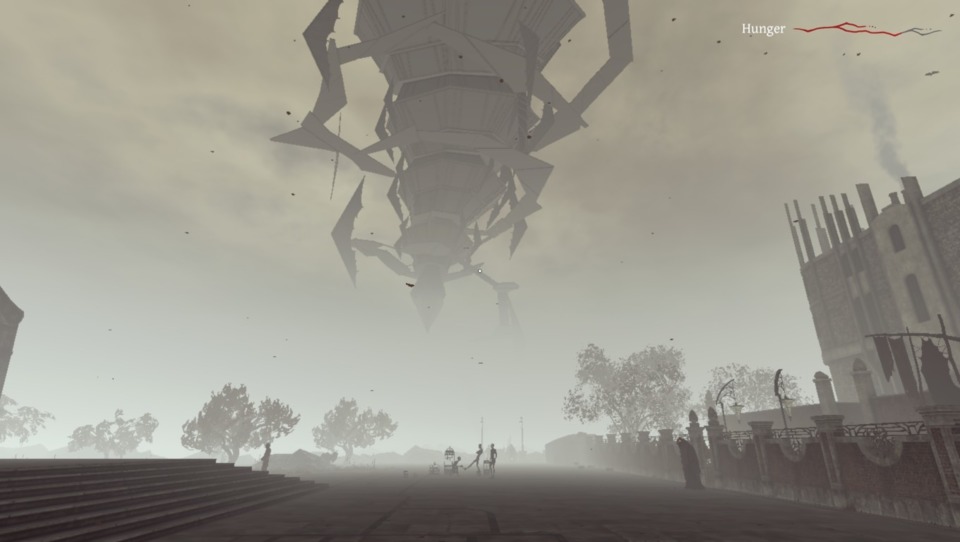
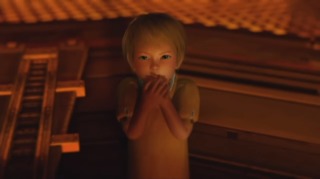
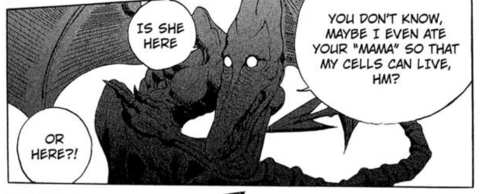
Log in to comment